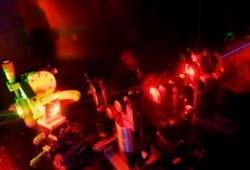Element Six and U. of Strathclyde create tunable CW diamond Raman lasers for bio, industry
Glasgow, Scotland and Ascot, England--Researchers at the University of Strathclyde and Element Six have developed diamond-based Raman lasers that produce higher-power beams with a wider range of colors than current Raman lasers, potentially opening up important new applications.
These uses range from better treatment of skin complaints and diabetes-related eye conditions to improved pollution monitoring and aeronautical engineering.
Two world firsts
The team has created the first-ever tunable diamond Raman lasers, in which the color of the light can be adjusted to meet specific needs—for example, the treatment of vascular lesions (and retinal bleeding of blood vessels at the back of the eyes as well) requires a yellow/orange light that is difficult to produce with conventional lasers, but which is needed to maximize absorption by the lesion while minimizing damage to surrounding tissue. Diamond’s optical properties enable diamond lasers to produce these colors, which are hard to generate by conventional means.
The team also created the first-ever continuous-wave (CW) diamond Raman laser. This is important because pulsed lasers are unsuited to some medical and other applications—for example, where pulses would damage delicate structures in the eye due to acoustic disturbances.
This video describes the lasers in more detail:

John Wallace | Senior Technical Editor (1998-2022)
John Wallace was with Laser Focus World for nearly 25 years, retiring in late June 2022. He obtained a bachelor's degree in mechanical engineering and physics at Rutgers University and a master's in optical engineering at the University of Rochester. Before becoming an editor, John worked as an engineer at RCA, Exxon, Eastman Kodak, and GCA Corporation.
